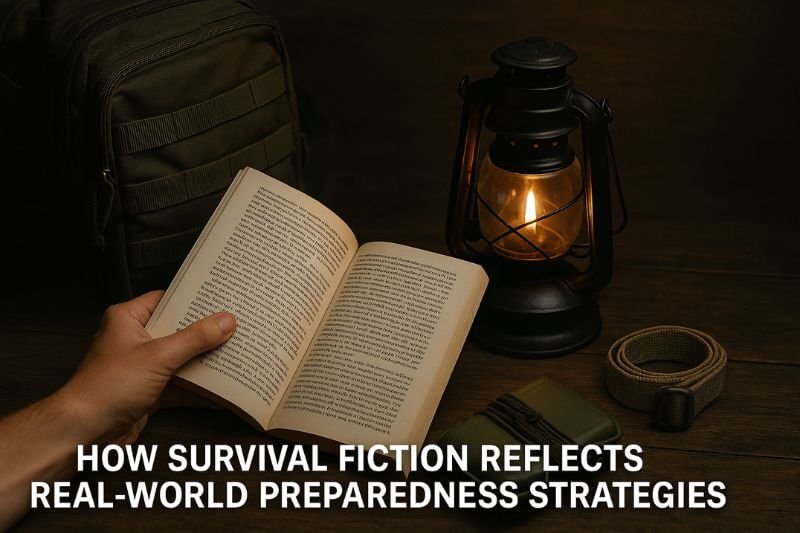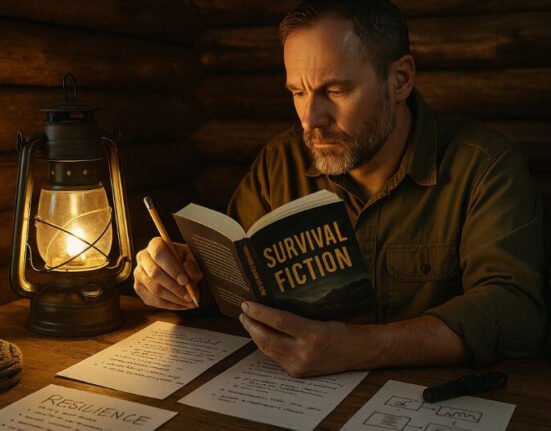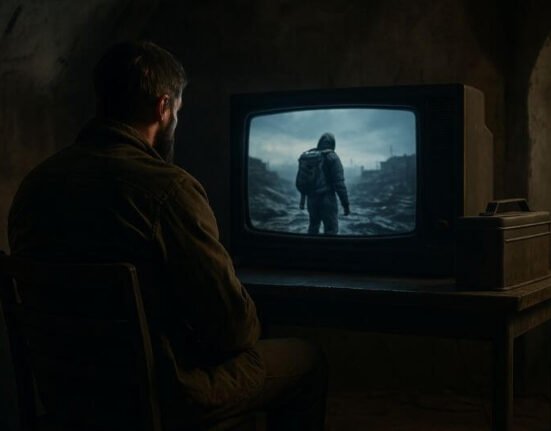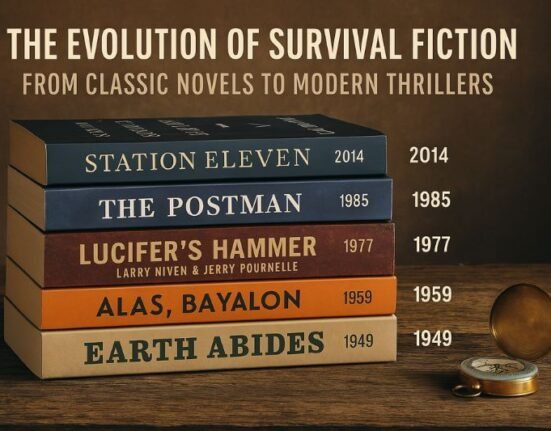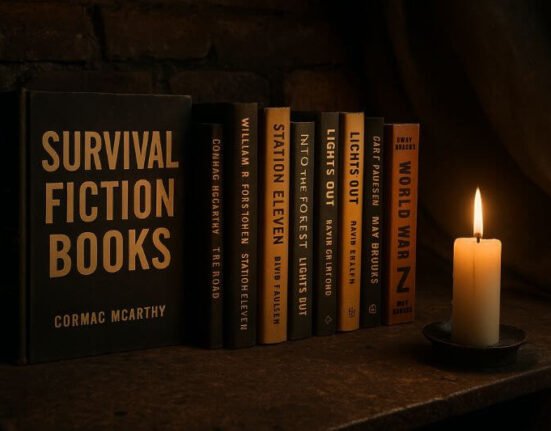Survival fiction isn’t just a subgenre of thrillers — it’s a mirror held up to our deepest fears and our survival instincts. Whether through pandemics, EMP strikes, societal collapse, or climate catastrophe, these fictional narratives often eerily anticipate real-life threats.
But beyond their tension and drama, these stories function as simulation exercises — emotional, moral, and strategic rehearsals that push readers to ask:
What would I do? Would I be ready? Could I survive that?
From the makeshift bunkers in One Second After to the quiet desperation in The Road, survival fiction isn’t just imagination — it’s applied psychology, scenario-based learning, and mental prepping disguised as entertainment.
🧠 Why Fiction is a Powerful Tool for Preparedness
Manuals tell us what to pack, how to purify water, or set up perimeter defense. But fiction teaches us:
- How panic spreads
- What it feels like when the grid dies
- How people turn — good or bad — when survival is at stake
Here’s why fiction is uniquely effective for prepping:
| Element | Fiction Triggers | Real-Life Application |
|---|---|---|
| Emotion | Empathy, fear, hope | Mental resilience |
| Scenario Exposure | Complex what-if logic | Decision-making in crisis |
| Repetition | Reading multiple stories | Pattern recognition |
| Identification | Readers live through characters | Situational awareness |
This is why many survivalists and military professionals read fiction as part of their training. Because when the mind rehearses through story, reactions come faster under pressure.
📚 Fictional Crisis, Real Lessons
Let’s explore concrete examples of how scenes in survival fiction align with actual prepping strategies.
📖 One Second After – The EMP Shock
- Fiction: A town in North Carolina loses power, internet, vehicles — everything — after an electromagnetic pulse (EMP).
- Reality: EMPs are a real threat recognized by U.S. government agencies.
- Prepper Strategy: Build layered supply chains, protect sensitive gear with Faraday cages, maintain paper maps and analog tools.
✅ The book popularized EMP awareness in the prepping community.
📖 Into the Forest – Collapse by Quiet Decline
- Fiction: No explosion. Just oil shortages, supply chain breakdown, and social unraveling.
- Reality: This “slow collapse” model mirrors what some experts call “soft failure” — where infrastructure fades gradually.
- Prepper Strategy: Learn bushcraft, food preservation, herbal medicine, and self-reliance.
✅ This novel emphasizes adaptation over confrontation.
📖 World War Z – Strategic, Not Just Survival
- Fiction: Global pandemic framed as a sociological, logistical, and military problem.
- Reality: Echoes of COVID-19, war-game simulations, and the importance of national/international planning.
- Prepper Strategy: Think in systems — not just your bunker, but supply chains, migration, information warfare.
✅ Even the U.S. Army has cited this book as useful for thinking outside the box.
🧩 Fictional Characters as Prepper Archetypes
In survival fiction, the characters aren’t just tools of the story — they’re often blueprints of survival psychology. Their reactions, flaws, and strengths reflect the real range of human responses in crisis.
Here are the most common archetypes found in fiction, and what they teach us:
🎯 The Reluctant Leader
Example: John Matherson in “One Second After”
- Traits: Doesn’t seek power, but rises to the occasion. Thinks in terms of group survival.
- Real-World Parallel: Many effective community leaders during disasters are not politicians — they’re trusted civilians with calm judgment.
- Lesson: Leadership isn’t about ego; it’s about resilience, ethics, and action.
🔥 The Lone Wolf
Example: Hig in “The Dog Stars”
- Traits: Withdrawn, observant, self-reliant — but emotionally scarred.
- Prepper Insight: Isolation has tactical value, but emotional resilience matters too.
- Lesson: Surviving alone is harder than fiction portrays. Loneliness is a prep too.
🧠 The Strategist
Example: Todd Wainio in “World War Z”
- Traits: Analytical, calm under pressure, sees the big picture.
- Real-World Parallel: Planners, engineers, system thinkers.
- Lesson: Don’t just stock supplies — map systems, risks, contingencies.
🥾 The Improviser
Example: The unnamed man in “The Road”
- Traits: Makes do with what he finds, adapts constantly, rarely plans ahead.
- Reality Check: Resourcefulness is key when plans fail.
- Lesson: Learn how to create tools, repurpose items, and survive in scarcity.
❤️ The Caregiver
Example: Nell in “Into the Forest”
- Traits: Protects others, often sacrifices own comfort for the group.
- Real Insight: In a real crisis, empathy and emotional strength are survival tools.
- Lesson: Keep your humanity. It’s not weakness — it’s continuity.
🧠 Moral Dilemmas in Fiction = Mental Prepping
What separates survival fiction from pure action is moral depth.
Preppers often focus on tools, food, gear. But decisions in collapse are rarely technical — they’re moral:
- Do you share food with a starving stranger?
- Do you lie to your group to keep morale up?
- Do you kill a thief to protect supplies?
These are questions characters face in stories like:
- The Stand by Stephen King
- Station Eleven by Emily St. John Mandel
- The Road by Cormac McCarthy
➡️ These books train your ethical compass before the crisis hits. That’s part of real preparedness.
🧠 Why Survival Fiction Belongs in Every Prepper’s Toolkit
You can stockpile gear. You can build shelters. You can train in self-defense. But when the real crisis comes — it’s your mindset that will determine if you freeze, flee, or fight.
Survival fiction isn’t fluff. It’s mental armor.
These stories simulate collapse, chaos, isolation, leadership, grief, and hope — in ways no manual ever can.
Reading survival fiction:
- Sharpens your decision-making under stress
- Exposes you to diverse threat scenarios
- Builds your emotional tolerance to the unknown
If preparedness is 80% mindset and 20% gear — fiction trains the 80%.
📖 Challenge: For the next 30 days, read one survival fiction book per week.
📝 Keep a notepad nearby. Track:
- Survival tactics shown
- Moral dilemmas raised
- How you would respond differently
Then compare with our real-world prepping guides:
➡️ Mental Resilience in Crisis
➡️ Family Bug Out Planning
➡️ Urban vs Rural Survival Decisions
🎯 Turn entertainment into education. Because one day, fiction might become your reality.
❓ Frequently Asked Questions (FAQ)
Q: Is survival fiction really useful for preppers?
Absolutely. While it’s not a how-to guide, it sharpens scenario thinking, emotional response, and helps you visualize crisis response — all critical components of preparedness.
Q: Which survival fiction book should I start with?
If you want practical realism: One Second After
For psychological depth: The Road
For a global systems view: World War Z
For bushcraft and quiet collapse: Into the Forest
Q: How can I extract real lessons from a fictional story?
Ask:
- What threat is presented? (EMP, pandemic, collapse?)
- How do characters survive?
- What resources, skills, and decisions made the difference?
- Could I do better — or worse?
That’s how fiction becomes training.
Q: Is reading fiction enough?
No — it’s a starting point. Fiction provides the mental maps, but you still need training, tools, and real-world practice.
Q: Why is survival fiction growing in popularity?
Because reality is catching up. From pandemics to grid threats, more people are asking:
“What if the fiction was right?”
And the answer is: Sometimes… it is.









